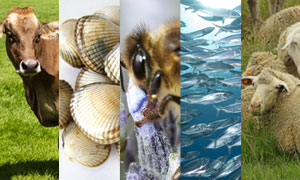The population studies which we carry out have the aim of contributing to the sustainable conservation and management of animal resources, by means of genetic markers. With the incorporation of the new and advanced Next–Generation Sequencing (NGS) technologies to our projects, our group has taken a large leap in this research line, moving from the genetics with which we initially began, to population genomics, which provides us with more information and facilitates the development of more efficient tools.
Many species are the object of our studies; from local livestock species (sheep, horses, cattle), to semi-wild and wild species (honeybee, termite, hare), and also, on occasion, the human species, with fish species being at present our principal objective. In addition, we are not limited to the study of local populations, and by means of recent collaborations with other European university groups and research centers, we also participate in world-wide studies, such as that aimed to improve our knowledge and understanding of the Atlantic Bluefin tuna (Thunnus thynnus) tuna stocks which we develop as members of the consortium contracted by the ICCAT.
The projects included in this line involve the design of panels of genetic markers, principally microsatellites and SNPs, which are optimized for each studied species and appropriate for the requirements inherent in the genetic characterization of populations, with the following two principal objectives in mind: (1) to characterize the intra- and inter-populational genetic diversity within the species and (2) to determine the evolutionary history of the populations.
The results obtained to date have contributed to the deepening of our knowledge of:
- The genetic structure and origin of horse breeds populations (Equus caballus) from the Basque Autonomous Community and Navarra.
- The population genetic structure of endangered bovine breeds (Bos taurus) in the Western Pyrenees.
- The genetic diversity of sheep breeds (Ovis aries) in the Northern Iberian Peninsula.
- The phylogeny and genetic structure of the bee (Apis mellifera) in Western Europe and the Canaries.
- The population genetic structure of the European anchovy (Engraulis encrasicolus) in the Bay of Biscay.
- The population genetic structure of the albacore (Thunus alalunga) on a world scale.
- The hybridization degree between different hare species in the Iberian Peninsula (Lepus castroviejoi, L. europaeus, L. granatensis).
- The genetic structure in colonies and subcolonies of species of underground termites Reticulitermes grassei and banyulensis.

